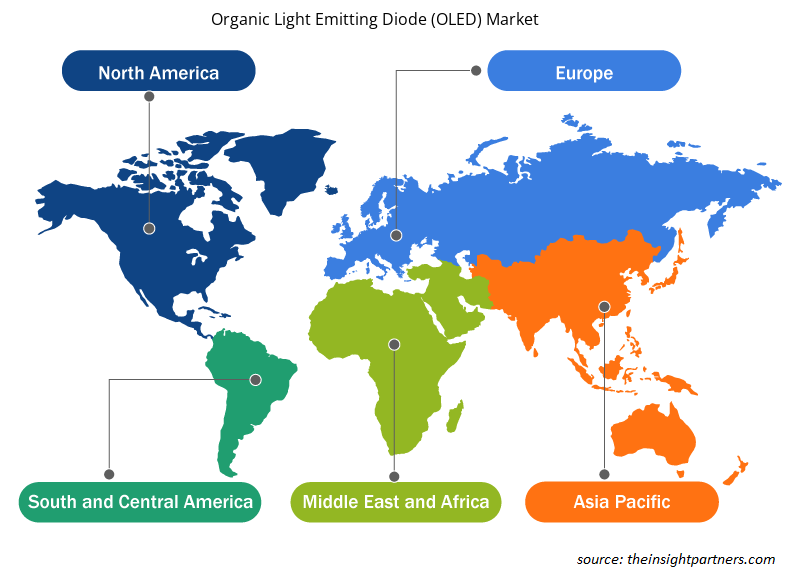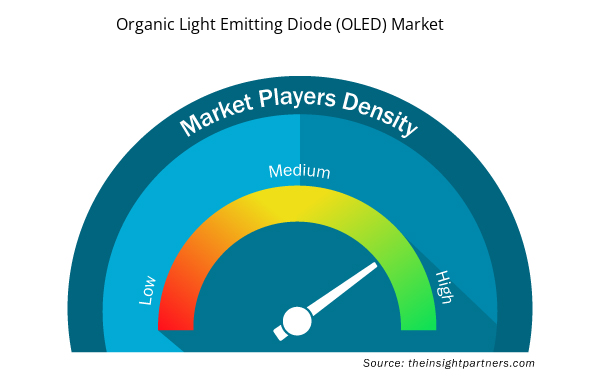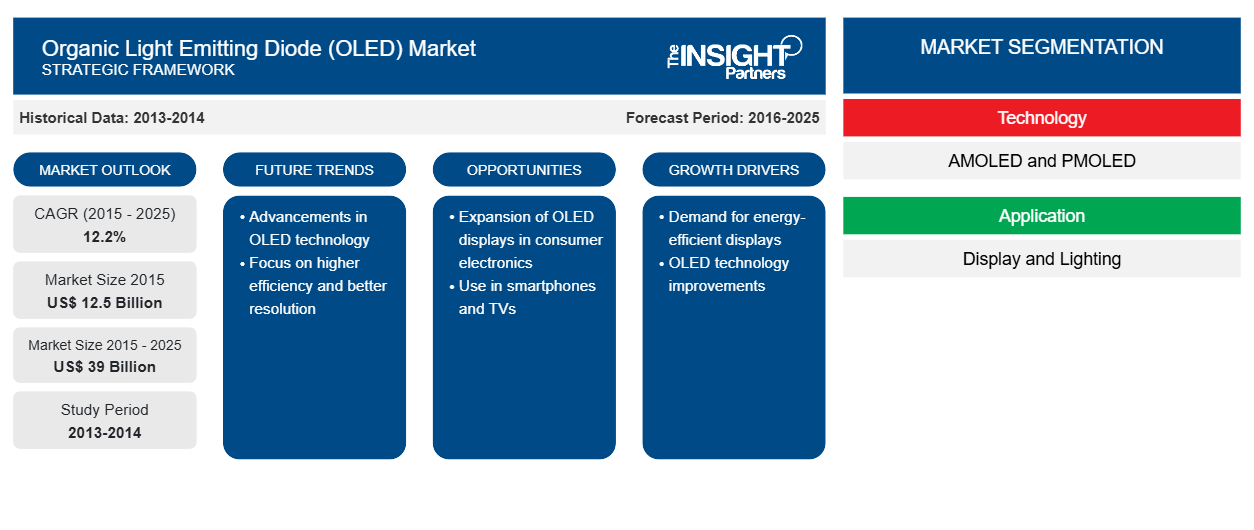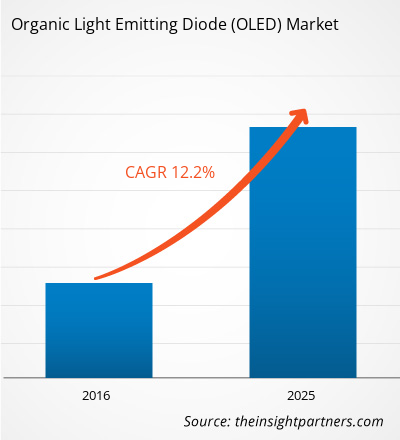بلغت قيمة سوق الصمام الثنائي الباعث للضوء العضوي (OLED) 12.5 مليار دولار أمريكي في عام 2015 ومن المتوقع أن تصل إلى 39.0 مليار دولار أمريكي في عام 2025؛ ومن المتوقع أن تنمو بمعدل نمو سنوي مركب قدره 12.2٪ من عام 2015 إلى عام 2025.
تتكون شاشات OLED من بوليمرات تصدر الضوء عند تطبيق تيار كهربائي عليها. وهناك تطبيقات مختلفة تستخدم فيها شاشات OLED مثل البيع بالتجزئة والأمن والسيارات والهندسة المعمارية وغيرها. وتستخدم تقنية OLED في مجموعة واسعة من الأجهزة الإلكترونية الاستهلاكية بما في ذلك شاشات الهواتف المحمولة وسماعات الرأس التي تعمل بتقنية Bluetooth وشاشات الصوت في السيارات وأجهزة الألعاب المحمولة ومشغلات MP3 والكاميرات الرقمية وفي العديد من التطبيقات الصناعية الأخرى. ويتمثل مجالا التطبيق الرئيسيان لشاشات OLED في الإضاءة والعرض. وفي الوقت الحاضر، هناك ثلاث مناطق ذات جهود تطوير رئيسية لشاشات OLED المرنة وهي شرق آسيا وأوروبا وأمريكا الشمالية.
إن فرص سوق الصمامات الثنائية الباعثة للضوء العضوية (OLED) تنمو باستمرار ويتم إجراء استثمارات رأسمالية كبيرة لتسهيل المنتجات ذات الأسعار التنافسية في السنوات القادمة. لا تزال شاشات OLED المتاحة في السوق اليوم باهظة الثمن ولكن مع تقدم التكنولوجيا، من المتوقع أن تنخفض الأسعار. أدت التطورات الحالية في أداء العرض إلى تحسين القدرة التنافسية للمنتجات ومن المتوقع أن ينمو الطلب على الشاشات الأصغر حجمًا، وخاصة الهواتف الذكية، بمعدل فوري. بينما من المتوقع أن ينمو الطلب على أجهزة التلفزيون المسطحة المزودة بشاشات OLED في سوق الشاشات الكبيرة في المستقبل القريب.
ينقسم سوق OLED على أساس جغرافي إلى أمريكا الشمالية وأوروبا ومنطقة آسيا والمحيط الهادئ وسامسونج والشرق الأوسط وأفريقيا. إن إنتاج شاشات توفير الطاقة بما في ذلك التكنولوجيا الخضراء يدفع نمو سوق OLED في كل منطقة تقريبًا. مع زيادة الوعي العام بالمنتجات الصديقة للبيئة، تعمل شركات مثل Sony وApple وPhilips وSamsung على تحسين كفاءة العرض باستخدام OLED. مع العلم أن شاشات LCD والبلازما تستهلك المزيد من الطاقة، يقوم المنتجون أيضًا بإجراء تطويرات مع شاشات OLED التي تستهلك طاقة أقل وتوفر المرونة. يُظهر السيناريو الحالي في سوق OLED العالمي أن منطقة آسيا والمحيط الهادئ تهيمن على السوق تليها أمريكا الشمالية. تتركز شركتان رئيسيتان لتصنيع شاشات OLED وهما LG Display وSamsung Display بشكل أساسي في كوريا الجنوبية، وتركز كلتا الشركتين باستمرار على زيادة قدرتها الإنتاجية وتصنيع لوحات OLED كبيرة الحجم. بخلاف الشركات المذكورة أعلاه، فإن معظم شركات تصنيع شاشات OLED لها وجود في منطقة آسيا والمحيط الهادئ بشكل خاص، في تايوان والصين وتستثمر بشكل مكثف في البحث والتطوير لألواح OLED بهدف تعزيز الإنتاجية من خلال تقليل التكلفة المتكبدة في عملية التصنيع. ومن المتوقع أن يزداد النمو خلال الفترة المتوقعة مع ظهور شركات جديدة تستثمر في أعمال تصنيع OLED والتطورات الأخيرة التي تحدث لتطوير تقنية OLED.
رؤى السوق
زيادة استخدام شاشات العرض الصغيرة في مختلف القطاعات
أصبحت تقنية العرض جزءًا لا يتجزأ من حياتنا اليومية. الشاشة الصغيرة هي شاشة صغيرة للغاية يقل قياسها عن 25 مم عند قياسها قطريًا. تتميز وحدات العرض هذه بشاشات عالية الدقة وعالية الكثافة تستخدمها وحدات العرض المكبرة. تم تقديم شاشات العرض الصغيرة منذ ما يقرب من عقدين من الزمان. يتم تنفيذ شاشات العرض الصغيرة في مختلف القطاعات الصناعية مثل الصناعة والتجارة والفضاء والجيش والسيارات والطب وإنفاذ القانون والإنقاذ. تُستخدم شاشات العرض الصغيرة بشكل أساسي في HMDs وHUDs للجيش والفضاء. كانت Micro-OLED رائدة في تقديم شاشات عرض صغيرة تعتمد على OLED للقطاعات العسكرية والفضاء. تعمل وحدات العرض هذه على تحسين دقة الصورة وتستهلك طاقة أقل.
رؤى السوق القائمة على النوع
تنتج الثنائيات العضوية الباعثة للضوء (OLED) الضوء عند تغييرها بالتيارات الكهربائية. تتكون هذه الأجهزة بشكل أساسي من البوليمرات والجزيئات الصغيرة الأخرى ذات الطبيعة العضوية، وتعد بشكل ملحوظ بتطبيقات متعددة في الشاشات المسطحة لتحل محل التكنولوجيا القديمة لأنابيب أشعة الكاثود (CRT). تم تصنيف سوق OLED العالمي بشكل رئيسي إلى فئتين؛ الثنائيات العضوية الباعثة للضوء ذات المصفوفة السلبية (PMOLED) والثنائيات العضوية الباعثة للضوء ذات المصفوفة النشطة (AMOLED).
رؤى السوق القائمة على التطبيق
تم تقسيم سوق الصمامات الثنائية الباعثة للضوء العضوية العالمية على أساس التطبيق إلى شاشات OLED وإضاءة OLED. تُستخدم OLEDs لإنتاج شاشات رقمية في أجهزة مثل شاشات التلفزيون وشاشات الكمبيوتر والأجهزة المحمولة مثل وحدات التحكم في الألعاب المحمولة والهواتف المحمولة وأجهزة المساعد الرقمي الشخصي (PDA). تتمتع شاشة OLED بالقدرة على عرض مستويات سوداء عميقة وهي أخف وزناً وأرق مقارنة بشاشة LCD، حيث إنها لا تحتوي على إضاءة خلفية. تتكون مصابيح OLED من مادة أشباه الموصلات الموضوعة بين قطبين. OLED عبارة عن مزيج من طبقات رقيقة من الفيلم الأخضر والأزرق والأحمر لإطلاق ضوء أبيض أكثر نعومة.
رؤى السوق المستندة إلى المستخدم النهائي
تُسهِّل مرونة OLEDs على الشركات المصنعة إنشاء OLEDs باستخدام عمليات تصنيع البكرة إلى البكرة، وتمكّن من إنتاج منتجات الإضاءة والعرض المرنة. تُصنع OLEDs تجاريًا على ركائز زجاجية صلبة. ومع ذلك، فقد دخلت تطبيقات مثل الشاشات المنحنية أو الساعات ذات OLEDs المرنة السوق مؤخرًا. هناك حاجة إلى مزيد من تطوير عمليات الإنتاج والأدوات والمواد الأفضل لتطوير OLEDs مرنة ومتينة بدرجة كافية. يتم تقسيم السوق العالمية لـ OLEDs على أساس القطاعات الرأسية للمستخدم النهائي إلى إضاءة التجزئة والأمن واللافتات والسيارات والمنتجات الاستهلاكية والهندسة المعمارية وغيرها (الصناعية والأغذية والطبية وما إلى ذلك).
قم بتخصيص هذا التقرير ليناسب متطلباتك
ستحصل على تخصيص لأي تقرير - مجانًا - بما في ذلك أجزاء من هذا التقرير، أو تحليل على مستوى الدولة، وحزمة بيانات Excel، بالإضافة إلى الاستفادة من العروض والخصومات الرائعة للشركات الناشئة والجامعات
- احصل على أهم اتجاهات السوق الرئيسية لهذا التقرير.ستتضمن هذه العينة المجانية تحليلاً للبيانات، بدءًا من اتجاهات السوق وحتى التقديرات والتوقعات.
إن تطوير المنتجات هو الاستراتيجية التي تتبناها الشركات عادة لتوسيع محفظة منتجاتها. وتعد شركات Osram وOLEDWORKS وLG وAcuity Brands وغيرها من الشركات من اللاعبين الرئيسيين الذين ينفذون استراتيجيات لتوسيع قاعدة العملاء والحصول على حصة كبيرة في سوق الصمامات الثنائية الباعثة للضوء العضوية العالمية (OLED)، الأمر الذي يسمح لهم بدوره بالحفاظ على اسم علامتهم التجارية. وفيما يلي بعض التطورات الرئيسية الأخيرة:
- في عام 2014، أعلنت شركة Futaba Corporation عن تحالف رأس المال والأعمال مع شركة SANKO GOSEI LTD، الشركة المصنعة والبائعة لقوالب الصب ومنتجات القوالب البلاستيكية. وهذا من شأنه أن يسهل على الشركة تطوير منتجات وتقنيات جديدة، وزيادة الطلبات واستغلال السوق، ومشاركة المرافق وتبادل الممارسات في مجال الإدارة والإنتاج.
- في فبراير 2016، أعلنت شركة سامسونج أنها تقوم بتطوير لوحات تلفزيون OLED من خلال استثمار حوالي 3 مليار دولار أمريكي لإنتاج تلفزيون OLED.
رؤى إقليمية حول سوق الصمامات الثنائية الباعثة للضوء العضوية (OLED)
لقد قام المحللون في Insight Partners بشرح الاتجاهات والعوامل الإقليمية المؤثرة على سوق الصمام الثنائي الباعث للضوء العضوي (OLED) طوال فترة التوقعات بشكل شامل. يناقش هذا القسم أيضًا قطاعات سوق الصمام الثنائي الباعث للضوء العضوي (OLED) والجغرافيا في جميع أنحاء أمريكا الشمالية وأوروبا ومنطقة آسيا والمحيط الهادئ والشرق الأوسط وأفريقيا وأمريكا الجنوبية والوسطى.

- احصل على البيانات الإقليمية المحددة لسوق الصمام الثنائي الباعث للضوء العضوي (OLED)
نطاق تقرير سوق الصمام الثنائي الباعث للضوء العضوي (OLED)
| سمة التقرير | تفاصيل |
|---|---|
| حجم السوق في عام 2015 | 12.5 مليار دولار أمريكي |
| حجم السوق بحلول عام 2025 | 39 مليار دولار أمريكي |
| معدل النمو السنوي المركب العالمي (2015 - 2025) | 12.2% |
| البيانات التاريخية | 2013-2014 |
| فترة التنبؤ | 2016-2025 |
| القطاعات المغطاة | حسب التكنولوجيا
|
| المناطق والدول المغطاة | أمريكا الشمالية
|
| قادة السوق وملفات تعريف الشركات الرئيسية |
|
كثافة اللاعبين في السوق: فهم تأثيرها على ديناميكيات الأعمال
يشهد سوق الصمامات الثنائية الباعثة للضوء العضوية (OLED) نموًا سريعًا، مدفوعًا بالطلب المتزايد من المستخدم النهائي بسبب عوامل مثل تفضيلات المستهلكين المتطورة والتقدم التكنولوجي والوعي المتزايد بفوائد المنتج. ومع ارتفاع الطلب، تعمل الشركات على توسيع عروضها والابتكار لتلبية احتياجات المستهلكين والاستفادة من الاتجاهات الناشئة، مما يؤدي إلى زيادة نمو السوق.
تشير كثافة اللاعبين في السوق إلى توزيع الشركات أو المؤسسات العاملة في سوق أو صناعة معينة. وهي تشير إلى عدد المنافسين (اللاعبين في السوق) الموجودين في مساحة سوق معينة نسبة إلى حجمها أو قيمتها السوقية الإجمالية.
الشركات الرئيسية العاملة في سوق الصمام الثنائي الباعث للضوء العضوي (OLED) هي:
- شركة فوتابا
- شركة سامسونج للإلكترونيات المحدودة
- شركة يونيفرسال ديسبلاي
- شركة كونشان فيجنوكس لتكنولوجيا العرض المحدودة
- شركة DLC للعرض المحدودة
إخلاء المسؤولية : الشركات المذكورة أعلاه ليست مرتبة بأي ترتيب معين.

- احصل على نظرة عامة على أهم اللاعبين الرئيسيين في سوق الصمام الثنائي الباعث للضوء العضوي (OLED)
تجزئة سوق الصمام الثنائي الباعث للضوء العضوي (OLED):
سوق الصمامات الثنائية الباعثة للضوء العضوية (OLED) - حسب النوع
- الصمام الثنائي الباعث للضوء العضوي المصفوفي السلبي (PMOLED)
- مصفوفة نشطة من الصمامات الثنائية الباعثة للضوء العضوية (AMOLED).
سوق الصمامات الثنائية الباعثة للضوء العضوية (OLED) - حسب التطبيق
- شاشات OLED
- إضاءة OLED
سوق الصمامات الثنائية الباعثة للضوء العضوية (OLED) - حسب المستخدم النهائي
- إضاءة التجزئة
- الأمن واللافتات
- السيارات
- المنتجات الاستهلاكية
- بنيان
- آحرون
سوق الصمامات الثنائية الباعثة للضوء العضوية (OLED) - ملفات تعريف الشركة
- شاشة إل جي
- شركة سامسونج للشاشات المحدودة
- شركة فوتابا
- شركة يونيفرسال ديسبلاي
- شركة ريتيك
- شركة أوسرام المحدودة
- شركة OLEDWorks ذ.م.م
- شركة اينولوكس
- شركة سيكو إيبسون
- شركة أكويتي براندز للإضاءة
- شركة فيليبس الملكية
- التحليل التاريخي (سنتان)، السنة الأساسية، التوقعات (7 سنوات) مع معدل النمو السنوي المركب
- تحليل PEST و SWOT
- حجم السوق والقيمة / الحجم - عالميًا وإقليميًا وقطريًا
- الصناعة والمنافسة
- مجموعة بيانات Excel



Report Coverage
Revenue forecast, Company Analysis, Industry landscape, Growth factors, and Trends

Segment Covered
This text is related
to segments covered.

Regional Scope
North America, Europe, Asia Pacific, Middle East & Africa, South & Central America

Country Scope
This text is related
to country scope.
The List of Companies
- FUTABA CORPORATION
- Samsung Electronics Co., Ltd.
- Universal Display Corporation
- Kunshan Visionox Display Technology Co., Ltd
- DLC Display Co., Limited
- Pioneer Corporation
- Sony Corporation
- Koninklijke Philips N.V
- Acuity Brands Lighting Inc
- SEIKO EPSON CORPORATION
- Innolux Corporation
- OLEDWorks LLC
- LG Electronics Inc
- OSRAM GmbH
- RITEK Corporation
The Insight Partners performs research in 4 major stages: Data Collection & Secondary Research, Primary Research, Data Analysis and Data Triangulation & Final Review.
- Data Collection and Secondary Research:
As a market research and consulting firm operating from a decade, we have published and advised several client across the globe. First step for any study will start with an assessment of currently available data and insights from existing reports. Further, historical and current market information is collected from Investor Presentations, Annual Reports, SEC Filings, etc., and other information related to company’s performance and market positioning are gathered from Paid Databases (Factiva, Hoovers, and Reuters) and various other publications available in public domain.
Several associations trade associates, technical forums, institutes, societies and organization are accessed to gain technical as well as market related insights through their publications such as research papers, blogs and press releases related to the studies are referred to get cues about the market. Further, white papers, journals, magazines, and other news articles published in last 3 years are scrutinized and analyzed to understand the current market trends.
- Primary Research:
The primarily interview analysis comprise of data obtained from industry participants interview and answers to survey questions gathered by in-house primary team.
For primary research, interviews are conducted with industry experts/CEOs/Marketing Managers/VPs/Subject Matter Experts from both demand and supply side to get a 360-degree view of the market. The primary team conducts several interviews based on the complexity of the markets to understand the various market trends and dynamics which makes research more credible and precise.
A typical research interview fulfils the following functions:
- Provides first-hand information on the market size, market trends, growth trends, competitive landscape, and outlook
- Validates and strengthens in-house secondary research findings
- Develops the analysis team’s expertise and market understanding
Primary research involves email interactions and telephone interviews for each market, category, segment, and sub-segment across geographies. The participants who typically take part in such a process include, but are not limited to:
- Industry participants: VPs, business development managers, market intelligence managers and national sales managers
- Outside experts: Valuation experts, research analysts and key opinion leaders specializing in the electronics and semiconductor industry.
Below is the breakup of our primary respondents by company, designation, and region:

Once we receive the confirmation from primary research sources or primary respondents, we finalize the base year market estimation and forecast the data as per the macroeconomic and microeconomic factors assessed during data collection.
- Data Analysis:
Once data is validated through both secondary as well as primary respondents, we finalize the market estimations by hypothesis formulation and factor analysis at regional and country level.
- Macro-Economic Factor Analysis:
We analyse macroeconomic indicators such the gross domestic product (GDP), increase in the demand for goods and services across industries, technological advancement, regional economic growth, governmental policies, the influence of COVID-19, PEST analysis, and other aspects. This analysis aids in setting benchmarks for various nations/regions and approximating market splits. Additionally, the general trend of the aforementioned components aid in determining the market's development possibilities.
- Country Level Data:
Various factors that are especially aligned to the country are taken into account to determine the market size for a certain area and country, including the presence of vendors, such as headquarters and offices, the country's GDP, demand patterns, and industry growth. To comprehend the market dynamics for the nation, a number of growth variables, inhibitors, application areas, and current market trends are researched. The aforementioned elements aid in determining the country's overall market's growth potential.
- Company Profile:
The “Table of Contents” is formulated by listing and analyzing more than 25 - 30 companies operating in the market ecosystem across geographies. However, we profile only 10 companies as a standard practice in our syndicate reports. These 10 companies comprise leading, emerging, and regional players. Nonetheless, our analysis is not restricted to the 10 listed companies, we also analyze other companies present in the market to develop a holistic view and understand the prevailing trends. The “Company Profiles” section in the report covers key facts, business description, products & services, financial information, SWOT analysis, and key developments. The financial information presented is extracted from the annual reports and official documents of the publicly listed companies. Upon collecting the information for the sections of respective companies, we verify them via various primary sources and then compile the data in respective company profiles. The company level information helps us in deriving the base number as well as in forecasting the market size.
- Developing Base Number:
Aggregation of sales statistics (2020-2022) and macro-economic factor, and other secondary and primary research insights are utilized to arrive at base number and related market shares for 2022. The data gaps are identified in this step and relevant market data is analyzed, collected from paid primary interviews or databases. On finalizing the base year market size, forecasts are developed on the basis of macro-economic, industry and market growth factors and company level analysis.
- Data Triangulation and Final Review:
The market findings and base year market size calculations are validated from supply as well as demand side. Demand side validations are based on macro-economic factor analysis and benchmarks for respective regions and countries. In case of supply side validations, revenues of major companies are estimated (in case not available) based on industry benchmark, approximate number of employees, product portfolio, and primary interviews revenues are gathered. Further revenue from target product/service segment is assessed to avoid overshooting of market statistics. In case of heavy deviations between supply and demand side values, all thes steps are repeated to achieve synchronization.
We follow an iterative model, wherein we share our research findings with Subject Matter Experts (SME’s) and Key Opinion Leaders (KOLs) until consensus view of the market is not formulated – this model negates any drastic deviation in the opinions of experts. Only validated and universally acceptable research findings are quoted in our reports.
We have important check points that we use to validate our research findings – which we call – data triangulation, where we validate the information, we generate from secondary sources with primary interviews and then we re-validate with our internal data bases and Subject matter experts. This comprehensive model enables us to deliver high quality, reliable data in shortest possible time.


 احصل على عينة مجانية لهذا التقرير
احصل على عينة مجانية لهذا التقرير